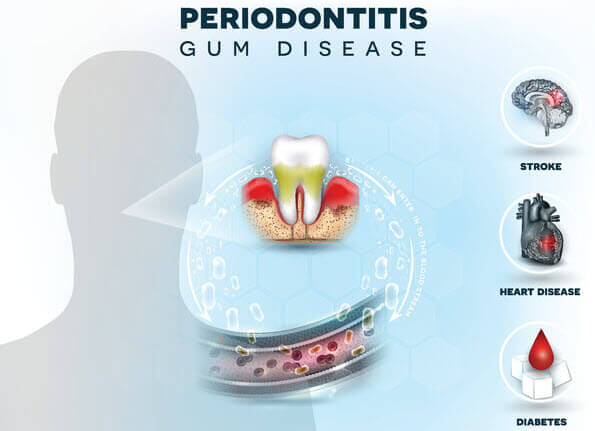According to the Centers for Disease Control and Prevention (CDC), almost half of all adults over the age of 30 show signs of gum disease, and approximately one in ten experience severe gum disease or periodontitis. The National Institute of Dental and Craniofacial Research also found that gum disease is the most common cause of tooth loss among adults. With statistics like these, the odds that you won’t experience gum disease during your lifetime are definitely not in your favor, but it doesn’t mean you are not able to control your oral health and take action to help prevent gum disease.
What is Gum Disease?
Gum disease also called gingivitis, makes your gums red, swollen, and bleed easily. Gingivitis is reversible with proper dental care, but if left untreated, it can turn into periodontitis. This inflammation around the tooth causes gums to pull away from the teeth and form pockets that become infected. If periodontitis is not treated professionally, the bones, gums, and tissue that support the teeth can become destroyed, resulting in tooth loss.
How to Minimize the Risk of Gum Disease
The best prevention for gum disease is daily oral hygiene and regularly scheduled cleanings and exams. If, however, your dentist informs you that you have gum disease, Dr. Kissel can provide you with professional scaling and root planing (also known as a deep cleaning) using a Perioscope to address plaque and tartar below the gum line, smooth root surfaces, and allow gums to heal. With the aid of the Perioscope (a powerful dental endoscope/microscope that can display a magnified image (24-48x) on a video screen), Dr. Kissel is able to clearly see any tartar you may have directly on the root of the affected tooth in large detail.
Other Factors Contributing to Gum Disease
Periodontal health can be affected by a number of outside factors other than poor oral hygiene. Knowing about these factors and attempting to manage or avoid them will help you minimize the risk of gum disease.
Tobacco Usage
Smoking and chewing tobacco are not only harmful to your health but also some of the leading causes of gum disease and tooth loss. When you use tobacco, you are more likely to develop calculus on your teeth and form deeper pockets between your gums and teeth. As a result, you can lose the bone and fibers that hold your teeth in place in your mouth. Additionally, tobacco usage slows down the healing process of gum disease treatment, making tobacco usage even more detrimental for gum disease patients.
Diabetes
Unfortunately, diabetes increases the risk of gum disease, especially for individuals with uncontrolled diabetes. Bacterial infections of the mouth result in tooth decay and loss as well as weaken the body’s ability to process insulin. This can make it even more difficult for you to control your diabetes and blood sugar levels. If you’re a diabetic, you can prevent your risk of developing gum disease by controlling your blood sugar levels and practicing proper oral hygiene.
Vitamin C Deficiency
Research has found that vitamin C deficiency is one of the leading causes of gum disease. By making sure you include the recommended intake of vitamin C in your diet you will help prevent gum disease from developing. In fact, if you experience mild gum disease, vitamin C can help stop your gums from swelling, receding, and bleeding.
Vitamin C has an antioxidant effect. It has the ability to neutralize free radical molecules, which in excess can damage cells. Since vitamin C scavenges excessive free radicals, it is considered to be an important dietary oxidant for periodontal health.
Diet
Studies have also shown that a balanced diet is important in helping prevent gum disease. It’s vital that you avoid sugary foods and drinks. As we all know, sugar can cause tooth decay and lead to gum damage. By following a balanced diet, your vitamin and mineral intake will help boost your immunity and prevent many diseases or infections, including gum disease.
The foods that can help in the development and maintenance of healthy gums are fibrous vegetables and fresh fruit since they are high in nutrients and may also assist in teeth cleaning. However, it’s important to remember that some fruits are high in natural sugar and/or have a high acidic content which can damage teeth and gums. So, you need to eat fruit in moderation.
Where you can’t go wrong and should include as much as possible in your diet, are calcium-rich foods. These include dairy products, dark leafy vegetables like broccoli and spinach, and nuts like almonds.
What to do if You Develop Gum Disease
If you do develop gum disease, Dr. Kissel offers a variety of non-surgical treatments as the first line of defense. These may include microscope-assisted scaling and root planing with LANAP. In LANAP, Dr. Kissel uses gentle pulses of laser light to destroy bacteria and diseased tissue. He also breaks up tartar deposits in the gumline and uses techniques to encourage reattachment of gum tissue and bone regeneration. There is no cutting or sutures involved.
Dr. Kissel will only recommend surgery when absolutely necessary. Consult with New York gum disease expert Dr. Scott Kissel for the best in preventive periodontal care. Schedule a periodontal exam with Dr. Kissel at his Manhattan, New York periodontal office at (212) 702-9088 or contact him online. Dr. Kissel will develop a personalized gum disease treatment program to save your teeth and help you reclaim your beautiful smile.
